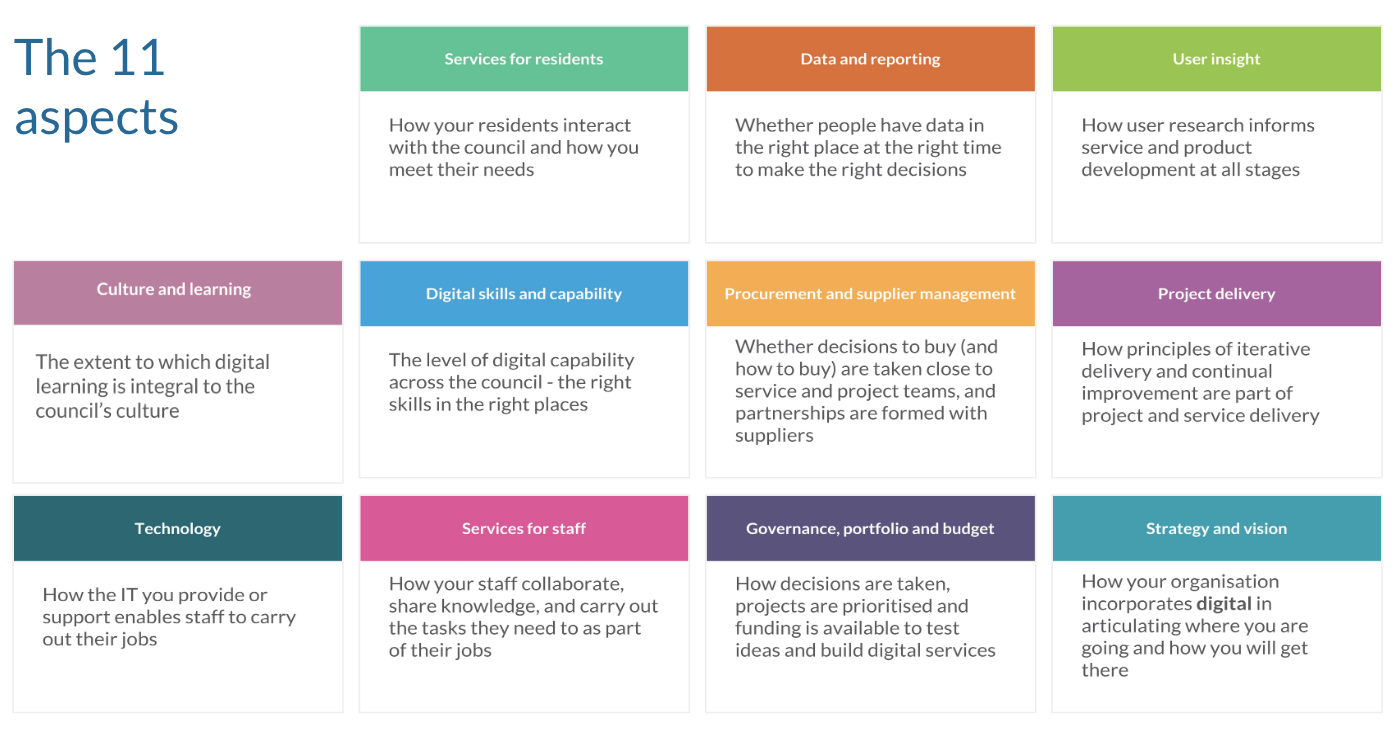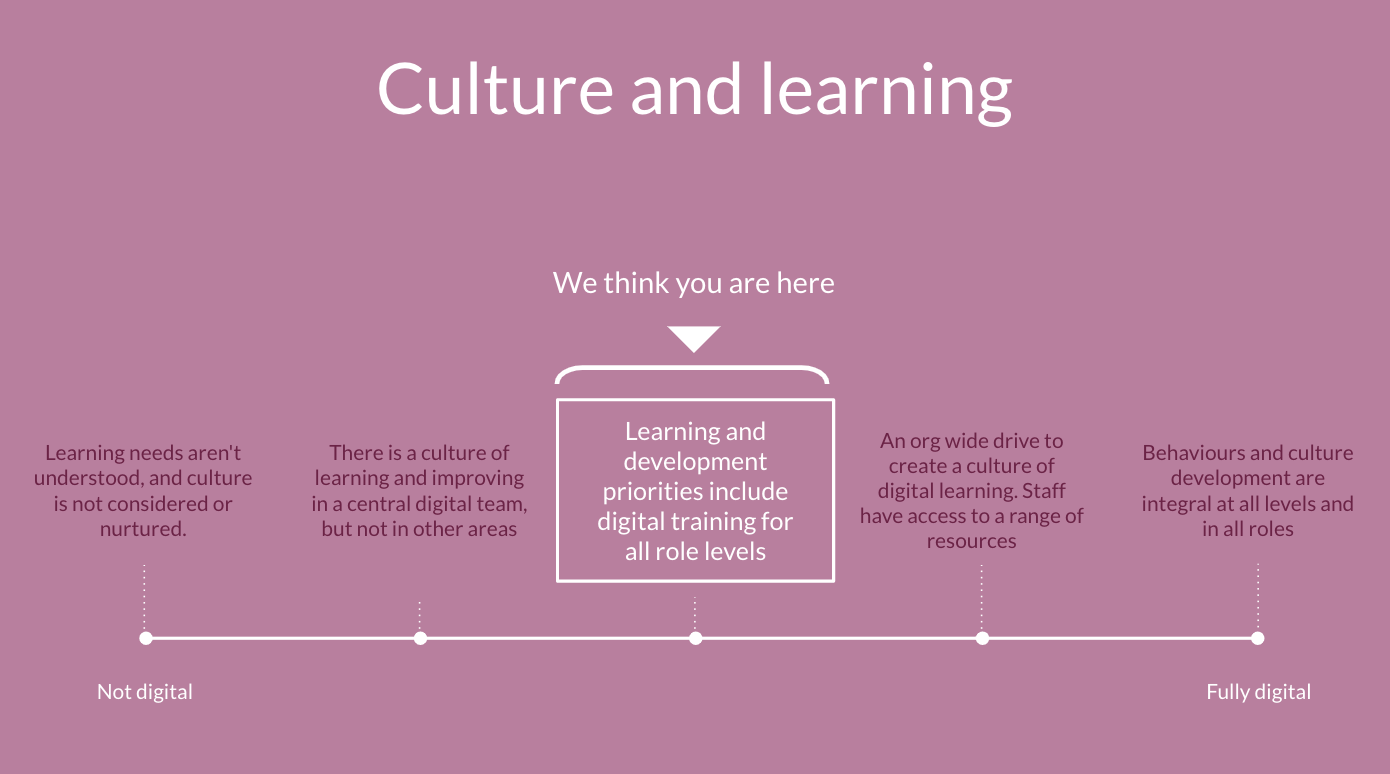Our approach to measuring digital capability and why it’s important

Defining what we mean by ‘digital’ is a critical first step
We work with public sector organisations to help them understand their digital maturity. What digital maturity means to us is the capability of an organisation to design and deliver change that meets their goals and the needs of their users.
It’s about both people – the skills and capabilities that an organisation needs to operate effectively in the internet age, and crucially the leadership, structures, technology, processes, and governance that bind an organisation together and create the environment for effective and sustainable delivery.
It’s about end-to-end service delivery, not just the website
Defining what we mean by ‘digital’ is a critical first step in these conversations. Digital means many things to many people. We love Tom Loosemore’s definition:
“Applying the culture, processes, business models & technologies of the internet era to respond to people’s raised expectations.”
Using this definition means we can describe how an organisation is able to use and apply digital in the way it designs its services, and the capabilities it has to support this way of operating. This includes the things that are obviously digital, like the website, but it also importantly extends across all end-to-end service delivery.
Why it’s so important
There are a number of common challenges facing organisations who want to start or accelerate their service improvement, and they hold back change:
- knowing where to start – organisations want to refocus their services to better serve their customers, but they don’t know what to prioritise
- strategy and vision – there can often be a void between organisational strategy and digital strategy – if the latter exists. Vision and strategy need to clearly articulate where you are going and how you will get there
- language – words like ‘digital’ and ‘agile’ can be inaccessible for people who aren’t used to working in software or digital delivery teams. They mean different things to different people, and without being explicit about what it means for the people responsible for services, you can’t build unity around change
- skills and capability – without the right skills, in the right places, you simply won’t be able to design and deliver services in a different way to how it’s always been done
- opportunities for testing and experimenting – often experimentation is not possible, meaning service owners have to commit large sums of budget to large projects with little opportunity to test
- procurement – traditionally IT and technology purchasing decisions have been dissociated from customers needs. Being more aware of how IT infrastructure impacts on customers is key for service owners and procurement teams
How to measure it
Measuring your digital maturity, and then translating the results into a practical roadmap you can follow, needs a tailored approach. An assessment of a transactional, single product agency will have a very different focus to an assessment for a large council that provides hundreds of services to a diverse range of users.
The approach we take is to:
- assess capability through delivery, rather than through theory
- benchmark against ambition, rather than against other organisations
- give you actionable steps, not just a report
- develop a prioritisation framework with you so you are ready to start
The 11 aspects of our digital maturity framework
We’ve developed a digital maturity framework that we use when we’re working with clients. At the core of the framework are 11 aspects of maturity that, taken together, provide a comprehensive set of lenses to measure how well set up an organisation is to deliver.

Because different organisations have different priorities and different focuses, we start with an inception workshop with senior leaders to establish which of these aspects are most important. This allows us to concentrate on the right questions so the assessment outputs are as useful and meaningful as possible.
We measure the aspects in different ways, but they always involve hands-on workshops, interviews, shadowing and testing how things really work in practice. This means we can get under the skin of an organisation and see how the different parts work together – strategy, policy, governance, technology and delivery – to meet customer needs.
A clear way ahead for your organisation
At the end of an assessment, we regroup with the organisation’s leadership to replay our findings and share our view on the level of maturity against each of the aspects we’ve focussed on. Our structured approach gives an easy to understand metric that shows a maturity level, and more importantly where improvements should be focussed to meet that organisation’s ambition.

The final part of the conversation is the agreement of a set of recommendations for the organisation to close the gap between their current position and their ambitions. These recommendations form a roadmap which is broken down into work that can be delivered and will have the most impact.
We’ll be blogging soon about our experience of using the framework with North Lincolnshire council. If you would like to find out more, please get in touch.